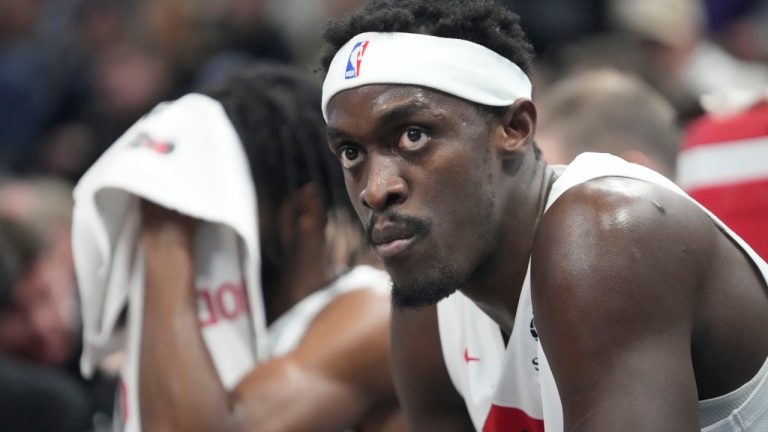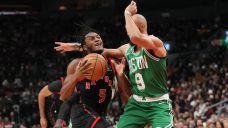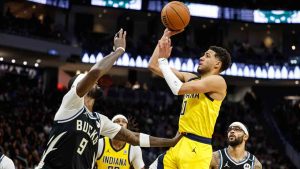TORONTO — Stalemate, checkmate or moving date?
The Toronto Raptors' awkward dance with Pascal Siakam continues, though it seems increasingly inevitable that it’s going to end with the two-time all-NBA forward and eight-year veteran being moved to a new organization sometime before the trade deadline on Feb. 8.
Last week, Siakam was going to be traded to the Sacramento Kings. Last night, it was the Indiana Pacers. Eventually, it feels like, a deal will be reached, and Siakam will be gone, even if sources close to either side have allowed that there remains some possibility, however slim, of Siakam staying with the club.
The two sides met in Los Angeles last week, but nothing definitive emerged, per sources. Trade speculation has only intensified since.
But how long Siakam will ultimately remain with the franchise that discovered him, drafted him and — thanks in no small part to his extraordinary motivation and work ethic — helped develop him into a star, is the pressing question, along with where he might end up and what the Raptors' return might be.
Will the change come in hours, days, or weeks? We’ll know when we know.
Judgements about whether the Raptors seemingly drawing this process out has hurt them — trying to trade a pending free agent this year compared with a player with who still had some term on his deal a year ago — will have to wait until a deal actually comes to pass.
But based on the rumoured returns (in the case of a theoretical deal with the Pacers that means some expiring veteran contracts, some (likely) middling future first-round picks and no guarantee of any of their most desirable young players such as Montrealer Bennedict Mathurin or Toronto’s Andrew Nembhard being included) the idea of a home-run trade is more wishful than practical at this point.
As one front-office person I spoke with recently put it, in situations like this: “The longer you wait, what are you gonna get?”
Similarly, another league insider summed it up this way: “There’s a point in these things where the leverage shifts. Instead of the team holding the cards and calling the shots, all of a sudden they’re left with a player who is about to be a free agent, has all the say about where he’s going to go, and you have owners asking questions and media asking questions and management has no good answers.”
But leverage isn’t static. Being a free agent — even for a player as accomplished as Siakam — isn’t always what it’s cracked up to be. Hitting the open market without a deal in hand means being subject to a myriad of forces beyond anyone’s control. Teams that are projected to have cap space may choose not to make the moves needed to have a max-salary slot available. Or teams that do have room look at the field, realize they’re one of the few clubs able to offer top dollar, and so try to whittle down the term or the money — or both.
It's high stakes musical chairs and not having a place to land when the music stops can be a life-altering event.
All of this is going on in an environment where teams are being more cautious than ever about being locked into long-term salary obligations that can limit future flexibility. The most recent collective-bargaining agreement has introduced significant penalties and roster-building restrictions that kick in for the 2024-25 season for teams that spend above the ‘second apron.'
Essentially, it’s an effort to reign in the league’s ‘super-spenders’: the Los Angeles Clippers, Golden State Warriors and, recently, the Phoenix Suns, as examples. The result is a chill in the market as the days of teams simply amassing talent and worrying about the luxury-tax bill later are, at the very least, on hold as clubs try to gauge what the true impact will be on league business.
While it’s not a perfect comparison, league insiders did point to Kawhi Leonard’s recent extension with the Los Angeles Clippers as an example of a cooling market. There was a time when, even with Leonard’s injury history, the idea of him being signed to anything less than the highest dollar value he was eligible for was far-fetched. Instead, Leonard — who remains (when healthy) one of the top-five players in the league and among the few with a proven ability to lead teams to championships — signed for three years instead of four and for roughly 95 per cent of the dollar value. No one is taking up a collection for a guy signing a deal for $153 million guaranteed, but it could have been for four years and $190 million. That the Clippers are trying to find savings while dealing with their most important player has been noted.
A different but related example is the Chicago Bulls struggling to find takers for Zach Lavine, who remains one of the most accomplished scorers and expert shooters in the league and could spark nearly any contender’s attack. But adding the remaining three years and $138 million on his contract to payrolls that are likely already at or above the luxury tax has teams thinking twice and ultimately taking a pass.
As it relates to Siakam trying to get paid and the Raptors trying to find a trade partner, it’s made for a less-than-robust market given that Siakam is thought to be determined to get a full max deal, which could be worth $183 million over four years as a free agent or five years and $247 if a team trades for him and has his Bird rights.
One league source I spoke with recently emphasized that the ultimate goal should be for Siakam to get a contract he deserves from a team he’s happy to play for, pointing out that going into free agency without the promise of a deal in hand creates its own set of risks. The market can shift instantly, teams that were projected to have cap space opt to keep their powder dry and next thing you know opportunists are swooping in offering short-term deals, or the only place to get real money and term is with the perpetually rebuilding Detroit Pistons.
“You never know what can happen in free agency,” he said. “There are maybe 10 guys in the league who would get full max no matter what … after that it’s more situational.”
Whatever ends up happening and whenever it does, also largely unknown for now is how the Raptors arrived at this point, with their leading scorer, most decorated player, last tangible link to their championship team, and perhaps the ultimate symbol of the talent identification and development success stories that were at the core of the franchise’s identity under Raptors president Masai Ujiri.
Consider what Ujiri had to say about Siakam at his season-ending press conference at the conclusion of the out-of-nowhere success story that was the 48-win 2021-22 campaign. Siakam had played his way back to all-NBA form after: his post-pandemic playoff no-show at the end of the 2019-20; a difficult season in the bubble in Tampa in 2020-21; off-season shoulder surgery and a late start to 2021-22. He stormed back to lead Toronto to a 34-17 record from Dec. 31, 48 wins and the fifth seed in the Eastern Conference and was effective in the Raptors' first-round exit against the Sixers in the playoffs too.
“I'm so proud of him … I want that guy on my team. I want that kind of fighter on my team,” Ujiri said in May 2022, when asked about the progress Siakam had made in the space of the previous 18 months. “If you can come back from that in life, you saw it: you saw what people called him, racist, all the things that were said [after the 2020 playoffs] about that guy because of basketball. Because of sports. Yeah, he gets paid, but he's also a human being. Right? And he withstood it [and] when he was coming back he got hit again, got injured. Those things crack people, right? … [but] to see him on that stage, fight and fight, that's who we want to go to war with, to battle with. I'm proud of him. Incredibly proud of Pascal.”
And yet eight months later, at the trade deadline a year ago, the Raptors were exploring trades for the then 28-year-old and have kept him front and centre of the league’s rumour mill since.
The full answer, or some versions of it, will likely come out in time, but in the essence of it is a battle over perceived value.
Siakam has been pushing for a deal at the highest range of what he can be paid, while the Raptors have resisted, not wanting to pay peak dollar for a player entering his 30s who hasn’t shown that — even at his best — he can change the trajectory of a team as its best player. It’s a harsh calculus.
“The hard part about this job is that you reach a point with guys who have been really good players for you, where you have to tell them at age 30, or 31, that you won’t pay them what they believe they are worth,” said one Western Conference team executive I spoke with recently. “Like, they’re great players, but they might only be worth 85 per cent of a full max, or 90 per cent. There’s no shame in that, but it’s a tough conversation.”
With Siakam and the Raptors, the cracks began to show in the lead up to the 2022-23 season. Toronto offered Siakam the most they could pay under the circumstances: a three-year extension worth 30 per cent of the salary cap that would have been paid him roughly $125 million and kept him under contract until the end of the 2026-27 season. But Siakam rejected the offer. He had an eye on earning all-NBA honours again. The thinking made sense: had he achieved all-NBA, Siakam would have been eligible for a four-year contract extension worth 35 per cent of the salary cap, or roughly $223 million.
But according to league sources, the Raptors were clear in their communication then: they didn’t plan to pay Siakam the supermax even if he qualified for it. An exception might be made if Siakam was first-team all-NBA, figured prominently in the MVP conversation, and led the Raptors on a deep playoff run.
In that context, Siakam was certainly aiming high: “I’ve been all-NBA, I’ve been an All-Star, I want to be a top-five player in the league,” he said on the eve of training camp a season ago. “I want to be one of the best and I’ll do everything I can do to work towards that.”
Siakam had a very good year, putting up career-high averages in points (24.2), assists (5.8) and leading the NBA in minutes per game for the second consecutive season, but team success didn’t follow. The Raptors stumbled to 41-41, finishing ninth in the East and losing at home in the play-in game.
Moreover, the season itself was a slog, as the team fell short of self-imposed expectations, which proved too ambitious in retrospect, while having so many core players in critical contract situations introduced another set of variables.
On a podcast, former Raptors guard Fred VanVleet recently summed up the whole season as “a drag.”
At his press conference at the trade deadline when the Raptors surprised the NBA and traded futures to acquire Jakob Poeltl (rather than trade core pieces for younger players and future picks) Ujiri suggested the Raptors were playing selfishly, a label he doubled down on at his end-of-season press conference, and again prior to the start of the 2023-24 campaign.
With VanVleet having left, signing with Houston as a free agent, it seemed that Siakam was being singled out.
“We do believe in Pascal,” Ujiri said on the eve of training camp. “[But] we believe that a lot of our players didn’t play the right way last year and we want to see them play the right way. I said that we were selfish, I’m not running away from that. We were selfish and we did not play the right way.”
The Raptors and Siakam’s camp were still in discussions about an extension at that point, though the semantics of whether one was actually formally presented or not are fuzzy enough to allow both sides some plausible deniability regarding a deal being offered and one being rejected, and the shades of grey in between.
But by the time the season started, the rift that had opened on the eve of the previous season — when Siakam made clear he wouldn’t sign a three-year extension while pursuing a ‘super-max’ and the Raptors suggested that there was no guarantee they would pay him the larger contract even if he qualified for it — had only grown more significant.
A report by one NBA insider in the minutes prior to the 2023 draft that indicated Siakam’s primary focus was to re-sign with Toronto and, as a pending free agent, would reject any attempts to sign him to an extension if the Raptors did trade him in the swirl around the draft and free agency, didn’t land well internally. The Raptors interpreted the leak as an effort to scuttle Siakam’s trade value and assert control in the contract negotiations.
Siakam’s camp has never denied the substance of the report but push back on the notion that the timing of it was calculated on their part, saying that it was the product of a previous conversation, and it was the reporter who resurfaced it at a moment of his choosing.
Regardless, by the time NBA Summer League rolled around, it was clear from various league sources Toronto was exploring trade opportunities, making the situation awkward enough that Siakam chose not to come to Las Vegas and train along with most of the Raptors' other returning veterans and meet the incoming rookies. Those close to him say he was both bewildered and heartbroken, to varying degrees, by the turn of events.
The NBA can be an arbitrary and brutal business at times — ‘that’s what the money is for’ is the catch-all mantra when nothing else makes sense. A split between Siakam and the Raptors will go down as one of the stranger ones in franchise history.
On one hand you have a player taken 27th overall all in the 2016 draft who has wildly exceeded any plausible projection for what his career would look like. Just this season alone, Siakam has cracked the franchise’s top five in scoring, assists and games played. On his current trajectory, the lanky, largely unknown prospect from Cameroon (via New Mexico State) would stand among the greatest players to ever where the uniform. He’s been central to the team’s ultimate successes, has been both durable and excellent on the job, and has been as sincerely and diligently connected to the community through a number or off-court initiatives as any player the Raptors have ever had. So many Raptors have wanted to leave while Siakam desperately wants to stay.
But the business of the NBA grinds on and wins, money, and perceived player value generally trump all.
As the trade deadline edges closer and the rumours have picked up, Siakam has done the only thing a player can do in his situation: deliver quality on-court performances. Those that know him say that any idea that circumstances he’s been playing under would affect his performance simply don’t know him well enough. At heart Siakam, remains the unknown underdog who turned himself into a star with a blue-collar approach. “That’s the thing about Pascal,” said one league source who has known Siakam since he was a fringe first-round draft prospect. “He didn’t come up getting the star treatment or having a sense of entitlement. No matter what happens, he just rolls his sleeves up and gets to work. That’s who he is.”
Siakam hasn’t said much regarding his present or his future. On the floor he’s played a lot, played well, and left it at that, for the most part. His per-minute production has matched or exceeded either of is all-NBA seasons even as the team’s style of play has shifted under head coach Darko Rajakovic. The main thing has remained the main thing.
“Literally, I go out every single day like I’m blessed to be in the best league in the world,” Siakam said the last time he was pressed about his take on being at the centre of trade talk yet again. “I want to be happy, I want to play meaningful basketball. I want to be successful. That’s pretty much it. All the speculation, that’s you guys’ thing. The rest of it? I can only control what I can control …”










COMMENTS
When submitting content, please abide by our submission guidelines, and avoid posting profanity, personal attacks or harassment. Should you violate our submissions guidelines, we reserve the right to remove your comments and block your account. Sportsnet reserves the right to close a story’s comment section at any time.